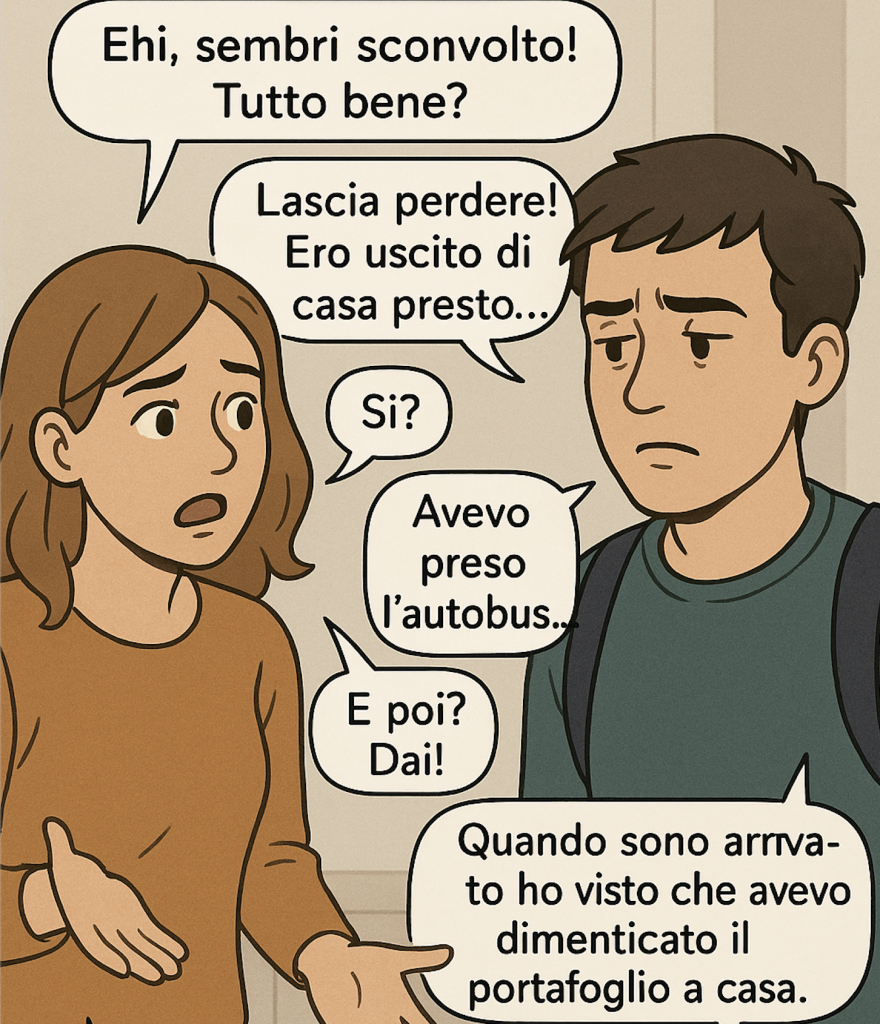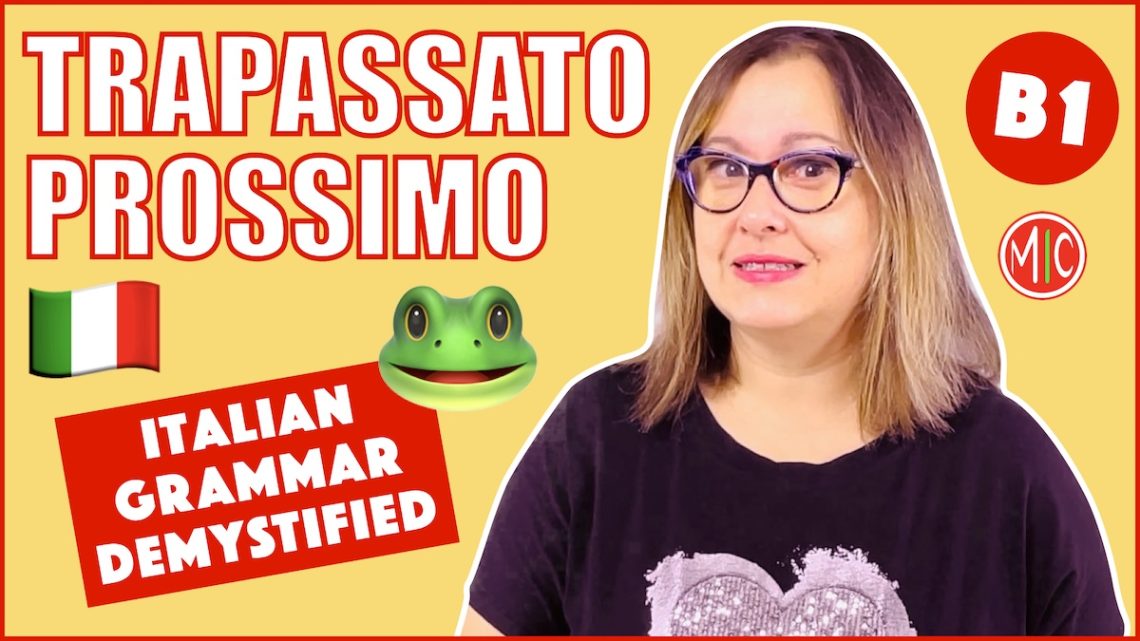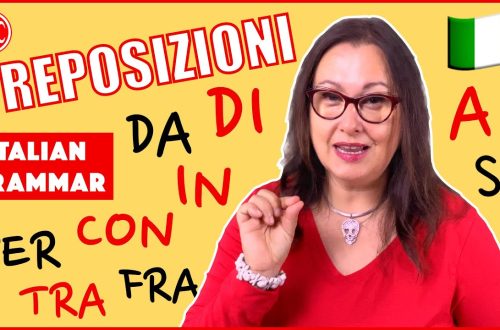
Have you ever told a story about the past… but starting from before the main event? Welcome to the fascinating world of the trapassato prossimo, the Italian past perfect. This tense lets you describe an action that happened even earlier than another past action.
La tensione cresce
Let’s read a short exchange between two friends, Marco and Giulia:
Giulia: Ehi, sembri sconvolto! Tutto bene?
Marco: Lascia perdere! Ero uscito di casa presto…
Giulia: Sì?
Marco: Avevo preso l’autobus…
Giulia: E poi? Dai!
Marco: Quando sono arrivato ho visto che avevo dimenticato il portafoglio a casa.
Giulia: Ma no! E cosa hai fatto?
Marco: Niente… sono tornato indietro, ma a quel punto avevo già perso il colloquio di lavoro.

Giulia: You look upset! Everything okay?
Marco: Don’t even ask… I had left the house early…
Giulia: Yeah?
Marco: I had taken the bus…
Giulia: And then? Come on!
Marco: When I got there I saw that I had forgotten my wallet at home.
Giulia: Oh no! What did you do?
Marco: Nothing… I went back, but by then I had already missed the job interview.
Can you see what’s happening? Marco builds tension using the trapassato prossimo, and only later reveals what happened in the end.
So, What Is the Trapassato?
In English, we call it the past perfect. In Italian, it’s formed like this:
Imperfetto of “essere” or “avere” + past participle of the main verb.
Examples:
- Avevo mangiato prima di uscire. – I had eaten before going out.
- Era arrivata troppo tardi. – She had arrived too late.
We use the trapassato to show that an action happened before another one in the past.
Sequence of past events; describing a state
1. Sequence of past events
Quando siamo arrivati, il film era già iniziato.
When we got there, the film had already started.
Ho perso il cellulare che avevo appena comprato.
I lost the phone that I had just bought.
2. With the imperfetto (describing a state)
Ero triste perché avevo ricevuto una brutta notizia.
I was sad because I had received bad news.
Volevo uscire, ma avevo dimenticato l’ombrello.
I wanted to go out, but I had forgotten my umbrella.
Be Careful with “prima di…”
If the subject of the sentence stays the same, you can use the trapassato with prima di + infinitive:
Avevo già fatto la spesa prima di tornare a casa.
I had already done the shopping before going home.
Luca aveva studiato molto prima di sostenere l’esame.
Luca had studied a lot before taking the exam.
The “Polite” Trapassato
Yes! Italians sometimes use the trapassato to sound more polite, especially in shops or formal situations:
Scusi, avevo visto una giacca rossa ieri… è ancora disponibile?
Excuse me, I had seen (= I saw) a red jacket yesterday… is it still available?
Ero venuto per chiedere un’informazione…
I had come (= I came) to ask for some information…
In these cases, you can also use the passato prossimo instead, and the meaning stays the same:
Scusi, ho visto una giacca rossa ieri…
Sono venuto per chiedere…
Using It Alone (With mai)
Sometimes the trapassato is used on its own, when the context makes the meaning clear. This often happens with the word mai (never):
Buono questo dolce! Non lo avevo mai assaggiato.
This dessert is great! I had never tasted it before.
Marco non era mai stato a Roma prima d’ora.
Marco had never been to Rome before now.
Let’s Recap!
Use the trapassato prossimo to:
- Talk about past actions that happened before other actions in the past.
- Describe emotional states or situations caused by earlier events.
- Make polite requests in formal or service situations.
- Express something that had never happened until that moment (often with mai).
Would you like to practice? Try writing a short story using at least three verbs in the trapassato prossimo. If you want, send it to me and I’ll give you some feedback. Don’t forget to watch our video lesson on this useful tense!
Anna






Prima di venire alla città di Colchester molti anni fa, avevo vissuto a Londra. Mi ero piaciuto la capitale più della campagna a quella volta, ma Londra diventava troppo occupato e rumorosa per me. Quindi mi ero mosso ed ero contento esserenin un’ambiente più rurale. Tuttavia, non era facile di fare perché anche se vivevo a Colchester ho continuato a lavorare a Londra e quindi ogni giorno ho passato quattro ore in treno a un costo enorme. Purtroppo, durante gli anni Colchester ha continuato ad espandersi e la mia zona non è molto rurale adesso sebbene la campagna sia almeno vicino a casa mia.
(Mi dispiace, ho fatto un errore). Prima di venire alla città di Colchester molti anni fa, avevo vissuto a Londra. Mi ero piaciuto la capitale più della campagna a quella volta, ma Londra diventava troppo occupato e rumorosa per me. Quindi mi ero mosso ed ero contento essere in un’ambiente più rurale. Tuttavia, non era facile di fare perché anche se vivevo a Colchester ho continuato a lavorare a Londra e quindi ogni giorno ho passato quattro ore in treno a un costo enorme. Purtroppo, durante gli anni Colchester ha continuato ad espandersi e la mia zona non è molto rurale adesso sebbene la campagna sia almeno vicino a casa mia.
Davide,
Grazie per aver scritto un lungo paragrafo! Ti sei trasferito a Colchester perché Londra era diventata troppo rumorosa e affollata? Lo capisco, le grandi città, soprattutto le grandi capitali, sono difficili. Ora sei felice a Colchester? O hai intenzione di trasferirti ancora?